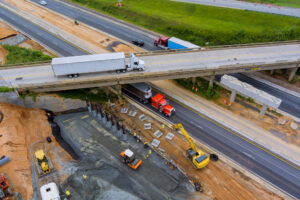Improvements in Construction Safety in 2023

The construction industry in the UK has seen steady improvements in safety over the past decade, but there is still work to be done.
Construction remains a high-risk occupation and 30 fatal injuries were reported by the Health and Safety Executive (HSE) in 2021-22. Although this is a slight drop compared to the longer-term average, there is still work to be done in improving site safety.
However, new initiatives look promising for further reducing accidents and improving worker safety.
How construction safety is improving
Advances in technology and equipment are routinely aimed at improving safety standards for all kinds of people on-site.
Some advancements have improved things by removing workers from dangerous situations. For example, drones are now capable of providing high-definition images for safety inspections in hard-to-reach places.
Other advancements better protect people, such as modern power tools being equipped with usage monitors and technology that prevents overloading.
Safety culture is also improving through better communication and collaboration between workers and management.
The influence of health and safety regulations
Stricter health and safety regulations have driven many safety advances and the Construction (Design and Management) Regulations 2015 make contractors and clients jointly responsible for minimizing risks.
Significant changes in recent years have included updated regulations surrounding Personal Protective Equipment (PPE), which has tightened up employers’ responsibilities to provide PPE to a wider range of workers.
Rules around reporting injuries and near misses provide valuable data to target prevention efforts, while continued enforcement of regulations will be key to further improvements.
How employee suggestions can help
Input from construction workers is invaluable for recognizing hazards and developing solutions. Site safety committees allow employees to voice concerns and propose improvements, while toolbox talks encourage discussion before shifts and suggestion boxes give workers an outlet to make suggestions without the pressure of confronting management.
For example, workers may identify a need for better site accommodation hire options to allow for breaks in a comfortable setting that allows them to properly relax and recharge. Safety must be a collaborative effort between management and site staff.
Mental health a bigger factor than ever
The construction industry is beginning to recognize mental health as a significant safety factor.
Construction has higher rates of work-related stress than most occupations and initiatives to reduce stigma and support mental wellbeing, like Mates in Mind, are expanding.
Providing mental health training and resources for managers and employees can help identify issues early, while a focus on work-life balance and flexibility is also emerging.
While risks remain, the construction industry is making strides in protecting its workers. New regulations, equipment, training programs and a focus on physical and mental health are driving continuous safety improvements.
However, sustained vigilance is necessary to reduce injuries, illnesses and fatalities. Workers and companies must work together to make safety the top priority.






